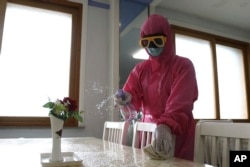For more than two years, as COVID-19 ravaged the rest of the world, North Korea insisted – almost impossibly, according to most experts – that it had not experienced a single coronavirus infection.
That changed in mid-May, when North Korea reported an explosion of suspected cases and mobilized the military to respond to what it described as a “major national emergency.”
Many foreign governments and international humanitarian groups feared the worst: that the outbreak in North Korea had grown so dire even Pyongyang could no longer attempt to hide it.
However, in the two weeks since North Korea disclosed the outbreak, state media have portrayed a rapidly improving situation.
The number of new and existing cases have plummeted since mid-May, according to daily figures published in the daily Rodong Sinmun. Over the past week, the state-run newspaper has reported only two outbreak-related deaths.
State media said Sunday that North Korean leader Kim Jong Un presided over a meeting where he "made a positive evaluation of the pandemic situation being controlled and improved across the country.”
Later the same day, a pandemic lockdown in the capital, Pyongyang, was partially loosened, according to multiple overseas outlets.
The mixed messages are puzzling to observers, who are trying to figure out why North Korea would finally admit to a COVID-19 outbreak only to publish official figures that are almost impossible to believe.
“Their stats simply make no sense,” said Christopher Green, a Korea specialist at Leiden University in the Netherlands. “We have a multitude of comparison cases – the world has been through this. There is no excuse for accepting [North Korea’s coronavirus figures] at face value.”
Fatality rate too low
As of Monday, North Korea has reported 3.55 million suspected COVID-19 cases, a figure that amounts to approximately 14% of the country’s total population. However, North Korean state media have reported only 70 deaths.
If North Korean figures are to be believed, the country has achieved a COVID-19 fatality rate of .002% – which would be by far the best in the world.
By comparison, South Korea has reported a COVID-19 fatality rate of .13%. Applying the South’s fatality rate to North Korea’s suspected cases would mean over 4,600 people have died.
But comparing the two Koreas is not likely to yield a meaningful result, since South Korea has an efficient and modern healthcare system and one of the world’s highest COVID-19 vaccination rates.
North Korea, on the other hand, has not begun mass coronavirus vaccinations and its healthcare system is inadequate, points out Jung Jae-hun, a preventative medicine specialist and COVID-19 policy advisor for the South Korean government.
“The North Korean figures appear to lack data,” Jung said.
Not enough tests
North Korea itself may not know the full extent of the outbreak, in large part because of a lack of COVID-19 test supplies.
For most of the past two years, North Korea reported regular COVID-19 testing figures to the World Health Organization, but those weekly figures never exceeded 1,800.
The lack of testing capacity may explain why North Korea has reported suspected “fever cases” rather than COVID-19 cases over the last two weeks.
Green says he also wouldn’t rule out the possibility that North Korea is willfully misrepresenting the situation.
“Through a mix of inadequate testing, disincentives at lower administrative levels to report serious outbreaks/cases/deaths, and whatever political motivations the top echelons may harbour, we have stats that are essentially nonsense,” Green added in a written message.
Assuaging elite fears
Why, then, did North Korea disclose the COVID-19 outbreak at all? Why couldn’t it continue to deny that the country had experienced any pandemic troubles?
One possible motivation? To reassure political elites in Pyongyang, which has experienced a heavy concentration of suspected cases.
Rachel Minyoung Lee with the 38 North Program at the Washington DC-based Stimson Center said North Korea’s new approach may be “at least in part intended to address Pyongyang residents’ concern and show them that top leadership was managing the crisis.”
“North Korea almost certainly reported on the COVID outbreak because the situation could no longer be contained quietly, and keeping the people informed was deemed crucial for managing the crisis effectively,” she said in a recent article.
A plea for help?
While some analysts speculated North Korea may have been disclosing the crisis as part of a plea for international assistance, Lee said that may not be the case this time. If it were, she said, North Korea’s outward-facing media likely would have published additional details highlighting the country’s pandemic difficulties.
North Korea has repeatedly rejected international offers for vaccines and other COVID-19 assistance, including through the United Nations-backed COVAX vaccine-sharing initiative
The country also does not likely have any effective COVID-19 treatment. Instead, state media have urged citizens to drink herbal tea, gargle salt water, and take pain relievers.
There are indications North Korea may be getting some help from China, its next-door neighbor. According to several media reports, three North Korean cargo planes picked up medical supplies in China and returned to Pyongyang earlier this month.
Last Friday, Reuters cited Chinese trade data indicating North Korea imported millions of face masks, 1,000 ventilators, and unidentified vaccines from China in the months before North Korea acknowledged the outbreak.
How the world can help
If North Korea really is experiencing a surge in cases, many experts say the international community should prioritize the provision of COVID-19 treatment pills, such as those produced by Pfizer and Merck.
“Pills are easy to transport and easy to deliver. The vaccine may be a little bit more challenging,” said David Hong, a U.S.-based pediatric neurosurgeon who has taken several humanitarian trips to North Korea.
But analysts say North Korea may not accept help if that help undermines its narrative of self-sufficiency.
“I think there’s a partial sense of they want to be able to do it on their own,” Hong said. “So I don’t know if it can be this high-publicity thing.”











